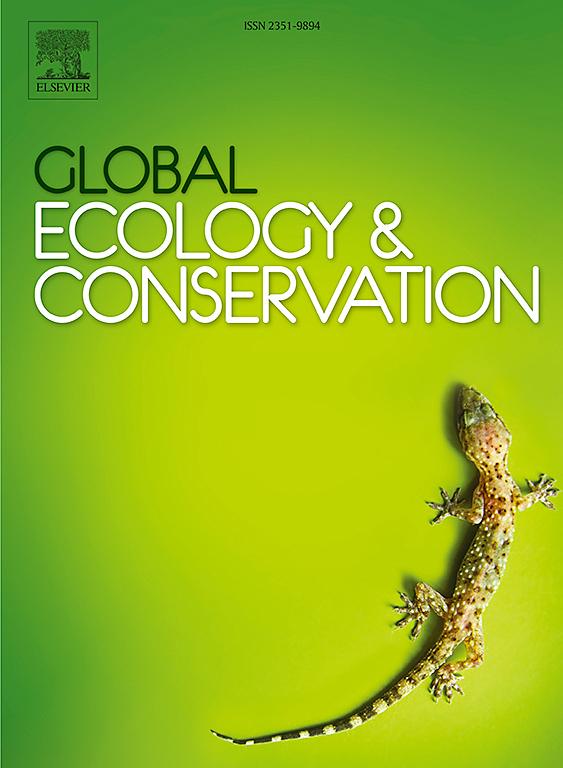未来环境变化下高度入侵性杂草 Lantana camara 的全球入侵风险评估
IF 3.5
2区 环境科学与生态学
Q1 BIODIVERSITY CONSERVATION
引用次数: 0
摘要
入侵风险评估对于做出明智决策、分配资源和实施有针对性的战略以防止或尽量减少入侵物种对本地生物多样性、农业生产力和自然生态系统的有害影响至关重要。本研究采用随机森林算法,评估了世界百大最严重入侵杂草之一的香蒲(Lantana camara)在当前和未来环境条件下在各大洲的空间入侵风险。在北纬 35° 和南纬 35° 左右的四大洲(即非洲、澳大利亚、大洋洲和南美洲),当前的入侵风险相对较高,估计至少覆盖了陆地总面积的 68.98%。此外,对未来环境变化的预测表明,各大洲的入侵风险都会大幅增加,与目前的入侵水平相比,欧洲的变化最为显著(251.52%)。此外,据预测,入侵风险将扩大到北纬 35 度以外。将 200 个国家和地区划分为不同的风险等级,27 个国家目前有可能受到入侵,114 个国家预计有可能引进和建立物种。此外,包括加拿大、印度、意大利和美国在内的至少 45 个国家预计将从无入侵风险或低入侵风险过渡到高入侵风险,28 个国家的风险增长超过 50%。目前的研究为了解 L. camara 的全球入侵风险提供了宝贵的信息。预计这些结果将对入侵杂草的管理大有裨益,有助于在全球和地方范围内针对这种臭名昭著的杂草制定控制和可持续管理策略。本文章由计算机程序翻译,如有差异,请以英文原文为准。
Global invasion risk assessment of Lantana camara, a highly invasive weed, under future environmental change
Invasion risk assessments are essential for making informed decisions, allocating resources, and implementing targeted strategies to prevent or minimize the harmful effects of invasive species on native biodiversity, agricultural productivity, and natural ecosystems. In this study, the random forest algorithm was used to assess the spatial invasion risk of Lantana camara, one of the world’s top 100 worst invasive weeds, across all continents under current and future environmental conditions. The current invasion risk was relatively high on four continents (i.e., Africa, Australia, Oceania, and South America) within approximately 35°N and 35°S latitude, estimated to cover at least 68.98 % of the total land surface. Furthermore, projections for future environmental changes suggested a substantial increase in invasion risk across all continents, with the most significant changes (251.52 %) observed in Europe compared with current invasion levels. Additionally, invasion risk was predicted to extend beyond 35°N latitude. Categorizing 200 countries and territories into distinct risk levels, 27 countries had current invasion potential, and introduction and establishment was predicted in 114 countries. Moreover, at least 45 countries, including Canada, India, Italy, and United States, were projected to transition from no or low invasion risk to high invasion risk and 28 countries had a risk increase of over 50 %. Current study provides valuable insights into the global invasion risk posed by L. camara. These results are expected to be of great utility for invasive weed management, facilitating the development of control and sustainable management strategies for this notorious weed at both global and local scales.
求助全文
通过发布文献求助,成功后即可免费获取论文全文。
去求助
来源期刊

Global Ecology and Conservation
Agricultural and Biological Sciences-Ecology, Evolution, Behavior and Systematics
CiteScore
8.10
自引率
5.00%
发文量
346
审稿时长
83 days
期刊介绍:
Global Ecology and Conservation is a peer-reviewed, open-access journal covering all sub-disciplines of ecological and conservation science: from theory to practice, from molecules to ecosystems, from regional to global. The fields covered include: organismal, population, community, and ecosystem ecology; physiological, evolutionary, and behavioral ecology; and conservation science.
 求助内容:
求助内容: 应助结果提醒方式:
应助结果提醒方式:


